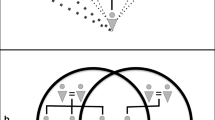Abstract
Changes in families over the past thirty years have created methodological challenges for research on family variation. Some argue that standard survey methods used for collecting data on families have been outpaced by the transformation of families and hence estimates of family variation are maccurate and opportunities for cross-country comparisons of family variation are hampered. This situation is rectifiable through greater use of relationship matrices. This underused data collection method can precisely portray family variation and facilitate cross-country comparisons. To illustrate the method’s usefulness for family research, relationship matrices data on young persons from Australia and the United States are exploited to: depict individuals’ living arrangements; identify patterns in partnering and childbearing; describe demographic diversity across types of couples; and compare family variation across countries.
Similar content being viewed by others
References
Bumpass, L.L. and H. Lu. 2000. Trends in cohabitation and implications for children’s family contexts.Population Studies 54(1):29–41.
Bumpass, L.L. and J.A. Sweet. 1989. National estimates of cohabitation.Demography 26(4): 615–625.
Casper, L. and S. Bianchi. 2002.Continuity and Change in the American Family. Thousand Oaks: Sage Publications.
Federal Interagency Forum on Child and Family Statistics. 2001.Counting Couples:, Improving Marriage, Divorce, Remarriage, and Cohabitation Data in the Federal Statistical System. Bethesda MD: Writing Subcommittee of the Data Collection Committee of the Forum, National Institute of Health.
Hofferth, S., P. Davis-Kean, J. Davis and J. Finkelstein. 1999.1997 User Guide: The Child Development Supplement to the Panel Study of Income Dynamics. Ann Arbor MI: Institute for Social Research, University of Michigan.
Teachman, J., L. Tedrow and K. Crowder. 2000. The changing demography of America’s families.Journal of Marriage and Family 62(4): 1234–1246.
US Census Bureau. 1999a. Living Arrangements of Children Under 18 Years Old: 1960 to Present. Internet Historical Time Series of Living Arrangements of Children, Table CH-1. Available at 〈http://www.census.gov/population/socdemo/ms-la/tabch-1.txt〉
US Census Bureau. 1999b. Living arrangements of black children under 18 years old: 1960 to present. Internet Historical Time Series of Living Arrangements of Children, Table CH-3. Available at 〈http://www.census.gov/population/socdemo/ms-la/tabch-3.txt⋆>
US Census Bureau. 1999c. Living arrangements of white children under 18 years old: 1960 to present. Internet Historical Time Series of Living Arrangements of Children, Table CH-2. Available at 〈http://www.census.gov/population/socdemo/ms-la/tabch-2.txt〉.
US Census Bureau. 2001.The Survey of Income and Program Participation (SIPP) Users Guide, Third edition. Washington DC: US Government Printer.
Watson, N. and M. Wooden. 2001. The Household, Income and Labour Dynamics in Australia (HILDA) Survey: an introduction to the proposed survey design and plan.Hilda Discussion Paper Series No. 1/00. Revised February 2001. Available at 〈http://www.melbourneinstitute. com/hilda/hdps/hdpsn01.pdf〉.
Author information
Authors and Affiliations
Corresponding author
Rights and permissions
About this article
Cite this article
Brandon, P.D. Utilizing relationship matrices to better understand the diversity of household arrangements among romantic couples: A cross-country example. Journal of Population Research 25, 251–265 (2008). https://doi.org/10.1007/BF03033890
Issue Date:
DOI: https://doi.org/10.1007/BF03033890




